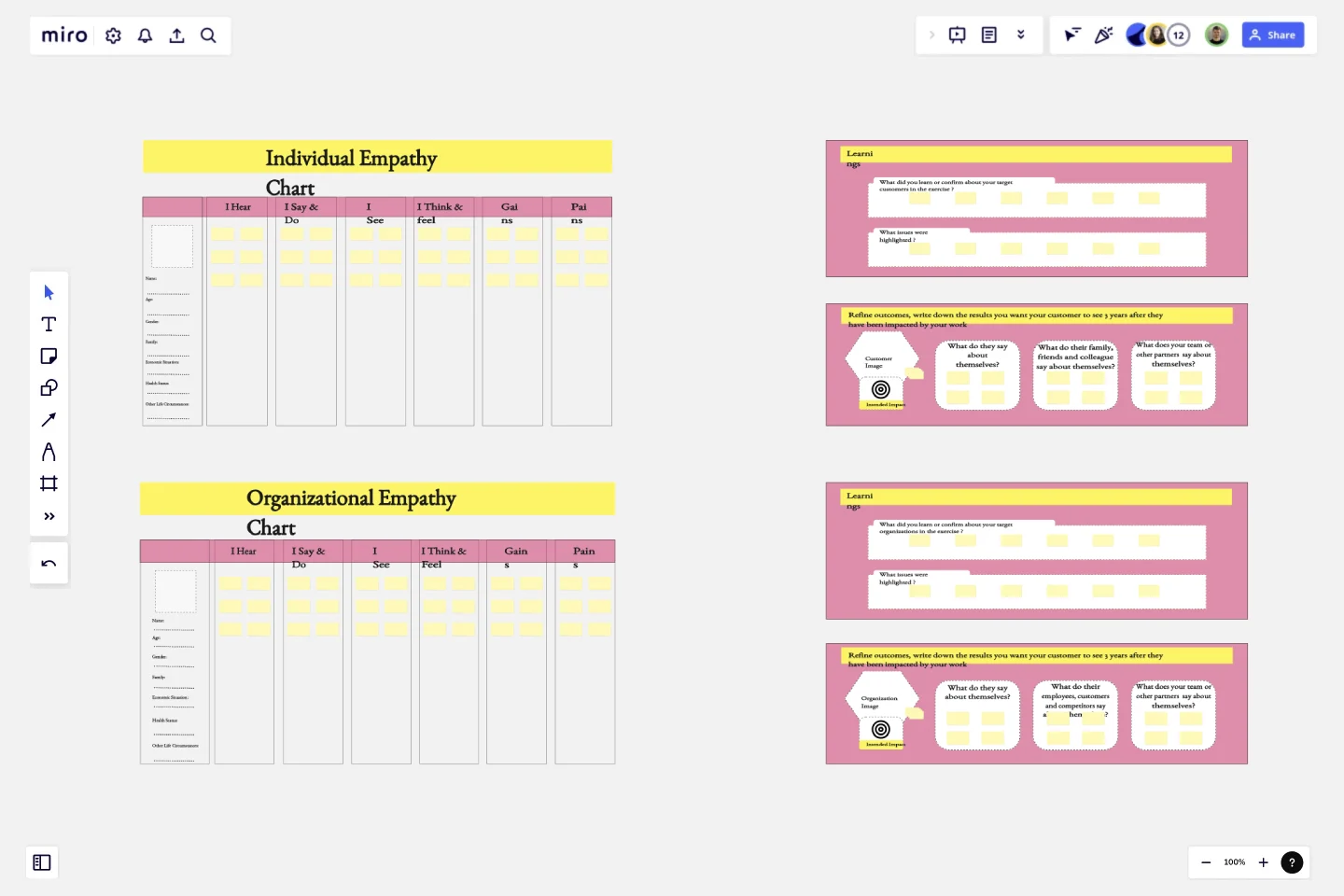Empathy Map by Aremu Dominion
Fill Out the Map/Table: Use our intuitive template to organize information into four key sections: "Says," "Thinks," "Feels," and "Does."What is an Empathy Map?
Explore the intricate landscape of your audience's thoughts, feelings, and motivations with our meticulously crafted Empathy Map template. Designed to illuminate the elusive realm of user experience, this tool offers a structured approach to understanding your users on a deeper level.
Benefits of an Empathy Map
Unlock the power of empathy and transform your understanding of your audience into actionable insights. Here’s how our Empathy Map template can revolutionize your strategy:
- Insightful Understanding: Gain profound insights into your users' desires, challenges, and aspirations.
- Enhanced Communication: Foster better communication and alignment across teams by creating a shared understanding of user needs.
- Informed Decision-Making: Make informed decisions based on real user data and emotions.
- Innovative Solutions: Inspire innovation by uncovering new opportunities and pain points.
- User-Centric Design: Create products and services that resonate deeply with your target audience.
How to Use an Empathy Map to Get the Best Results
Follow these steps to maximize the effectiveness of our Empathy Map template:
1. Define Your Persona: Start by identifying the persona (user/organization) segment you want to understand better.
2. Collect Data: Gather qualitative data through interviews, observations, or surveys to populate your Empathy Map.
3. Fill Out the Map/Table: Use our intuitive template to organize information into four key sections: "Says," "Thinks," "Feels," and "Does."
4. Identify Insights: Analyze the completed Empathy Map to uncover patterns, contradictions, and emotional triggers.
5. Prioritize Actions: Based on your insights, prioritize actions that address the most critical user needs or pain points.
6. Iterate and Improve: Continuously update your Empathy Map as you learn more about your users, ensuring ongoing relevance and accuracy.
Discover a deeper connection with your audience and elevate your strategy with our Empathy Map template. Start transforming user understanding into strategic advantage today!
This template was created by Aremu Dominion.
Get started with this template right now.
A Halloween Retro
Works best for:
Retrospectives, Meetings, Agile Methodology
The Retrospective Halloween template offers a themed approach to retrospectives, perfect for the spooky season. It provides elements for reflecting on past iterations, identifying scary issues, and brainstorming solutions. This template enables teams to have fun while addressing serious topics, fostering creativity and collaboration. By promoting a playful yet productive atmosphere, the Retrospective Halloween empowers teams to tackle challenges, drive improvement, and strengthen team cohesion effectively.
Good, Bad, Ideas, Action, Kudos Retrospective
Works best for:
Retrospectives, Meetings, Agile Methodology
The Good, Bad, Ideas, Action, Kudos Retrospective template offers a structured approach to retrospectives by categorizing feedback into five key areas: good, bad, ideas, action items, and kudos (appreciations). It provides elements for team members to share their thoughts, suggestions, and acknowledgments. This template enables teams to reflect on past performance, generate actionable insights, and celebrate achievements. By promoting inclusivity and constructive feedback, the Good, Bad, Ideas, Action, Kudos Retrospective empowers teams to foster collaboration, drive continuous improvement, and strengthen team dynamics effectively.
Product Positioning Canvas
Works best for:
Product Management, Planning
The Product Positioning Canvas template aids product managers in defining and communicating product positioning strategies. By analyzing target markets, competitive landscapes, and unique value propositions, this template helps differentiate products in the market. With sections for defining brand attributes, messaging, and market segments, it enables teams to craft compelling positioning statements that resonate with target audiences. This template serves as a guide for aligning product positioning with business objectives and driving market success.
The 4-Step Retrospective
Works best for:
Retrospectives, Agile Methodology, Meetings
The 4-Step Retrospective template offers a simple yet effective framework for conducting retrospectives. It provides steps for reflecting on what went well, what didn't go well, what could be improved, and action planning. This template enables teams to systematically review past iterations, identify areas for growth, and implement actionable improvements. By promoting a structured approach to reflection and improvement, the 4-Step Retrospective empowers teams to drive continuous learning and enhancement effectively.
Retrospective
Works best for:
Retrospective, Agile Methodology, Meetings
The Retrospective template offers a versatile and adaptable framework for teams to reflect on their performance and processes. It provides elements for sharing feedback, identifying lessons learned, and brainstorming improvements. This template enables teams to foster open communication, identify opportunities for growth, and enhance collaboration. By promoting reflection and transparency, the Retrospective empowers teams to continuously learn and evolve, driving greater efficiency and effectiveness in their work.
Empathy Map for Educational Purposes
Works best for:
Product Management
Enhance your educational approach with the Empathy Map for Educational Purposes template. This tool helps educators understand students' perspectives, needs, and emotions. Use it to create a more empathetic and effective teaching strategy, ensuring that your educational content resonates with and supports your students. Ideal for teachers and educational planners aiming to improve student engagement and learning outcomes.
